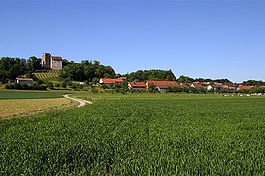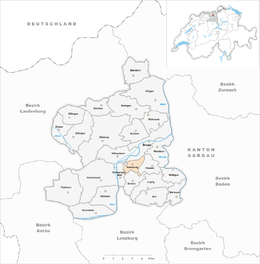Princely Countess of Habsburg
| Habsburg | ||
|---|---|---|

Habsburg village
|
||
|
||
| Coordinates: 47°28′N 8°11′E / 47.467°N 8.183°ECoordinates: 47°28′N 8°11′E / 47.467°N 8.183°E | ||
| Country | Switzerland | |
| Canton | Aargau | |
| District | Brugg | |
| Area | ||
| • Total | 2.23 km2 (0.86 sq mi) | |
| Elevation | 470 m (1,540 ft) | |
| Population (Dec 2015) | ||
| • Total | 407 | |
| • Density | 180/km2 (470/sq mi) | |
| Postal code | 5245 | |
| SFOS number | 4099 | |
| Surrounded by | Brugg, Hausen, Scherz, Schinznach-Bad | |
| Website |
www SFSO statistics |
|
Habsburg is a municipality in the district of Brugg in canton of Aargau in Switzerland. It lies about three kilometres southwest of the town of Brugg, the capital of the district of Brugg. Habsburg is named after Habsburg Castle, built around 1020-1030 for Count Radbot of the nearby county of Klettgau in the Duchy of Swabia, which Habsburg was also a part of at the time.
While Bronze Age and Roman era artifacts have been discovered, a village named Habsburg isn't mentioned until 1027, as Habesbur or Habeburch. This reference comes from a later (1114) copy of the original 1027 document. In 1114 it was mentioned Hauesborc.
The documentation of the village in 1027 is contemporary with Count Radbot's construction of Habsburg Castle. It is believed that he named the castle after a hawk (German: Habicht) seen sitting on its walls. Some historians and linguists believe the name may come from the Middle High German word 'hab / hap' meaning ford, as it is located near a ford of the Aar River. Habsburg Castle became the originating family seat of the House of Habsburg, which went on to become one of the leading royal dynasties in Europe.
Habsburg Castle remained the property of the House of Habsburg until 1415, when Duke Frederick IV of the Empty Pockets lost the canton of Aargau to the Swiss Confederacy.
...
Wikipedia




